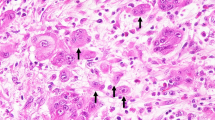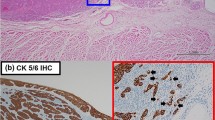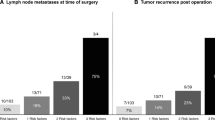Abstract
Background
Prognostic factors for superficial esophageal cancer cannot be limited to such factors as lymph node metastasis (N factor), depth of tumor invasion (T factor), and genetic alterations. The purpose of this study was to examine whether invasive growth patterns of tumors, such as infiltrative growth pattern c (INFc) and budding, represent new useful prognostic factors for superficial esophageal cancer.
Methods
We investigated 87 cases of superficial esophageal cancer in patients treated with radical surgery. First, the invasive growth pattern of the tumor was pathologically evaluated based on the traditional infiltrative growth pattern (INF) classification. Next, new INF criteria were proposed, and the invasive pattern was re-evaluated. We also investigated budding (Bud) in the stroma of the invasive frontal lesion.
Results
When the patients were divided into two groups, with and without an INFc component, the group with an INFc component had a poorer outcome than the group without an INFc component. When the group with an INFc component was defined as “new INFc”, new INFc was correlated with the T factor (p = 0.006) and the ly factor (lymphatic invasion) (p = 0.041). Bud was correlated with the T factor (p = 0.001), the N factor (p = 0.030), and new INFc (p < 0.001). An analysis of survival revealed new INFc (p = 0.002) and Bud (p = 0.006) to be prognostic factors. The survival of the group with new INFc(+)/Bud(+) was poorer than that with new INFc(−)/Bud(−) (p = 0.007).
Conclusions
New INFc and Bud, which represent new invasive patterns, were prognostic factors for superficial esophageal cancer.





Similar content being viewed by others
References
Kijima H, Chino O, Oshiba G, Tanaka H, Kenmochi T, Kise Y, et al. Immunohistochemical MUC1 (DF3 antigen) expression of human esophageal squamous cell carcinoma. Anticancer Res. 2001;21:1285–90.
Chino O, Kijima H, Shimada H, Nishi T, Tanaka H, Kise Y, et al. Accumulation of p53 in esophageal squamous cell carcinoma. Int J Mol Med. 2001;8:359–63.
Parenti AR, Rugge M, Shiao YH, Ruol A, Ancona E, Bozzola L, et al. bcl-2 and p53 immunophenotypes in pre-invasive, early and advanced oesophageal squamous cancer. Histopathology. 1997;31:430–5.
Makuuchi H, Shimada H, Mizutani K, Chino O, Kise Y, Nishi T, et al. Endoscopic criteria for invasive depth of superficial esophageal cancer. Dig Endosc. 1997;9:110–5.
Makuuchi H, Machimura T, Shimada H, Mizutani K, Osamu C, Kise Y, et al. Endoscopic screening for esophageal cancer in 788 patients with head and neck cancers. Tokai Exp Clin Med. 1996;21:139–45.
Endo M, Takeshita K, Koshiba M, Yamada Y. How can we diagnose the early stage of esophageal cancer? Endoscopic diagnosis. Endoscopy. 1996;18:11–8.
Makuuchi H. Endoscopic mucosal resection for early esophageal cancer: indication and techniques. Dig Endosc. 1996;8:175–9.
Teoh AY, Chiu PW, Yu Ngo DK, Wong SK, Lau JY, Ng EK. Outcomes of endoscopic submucosal dissection versus endoscopic mucosal resection in management of superficial squamous esophageal neoplasms outside Japan. J Clin Gastroenterol. 2010;44:190–4.
Inoue H, Minami H, Kaga M, Sato Y, Kudo SE. Endoscopic mucosal resection and endoscopic submucosal dissection for esophageal dysplasia and carcinoma. Gastrointest Endosc Clin N Am. 2010;20:25–34.
Makuuchi H, Shimada H, Mizutani K, Chino O, Nishi T, Tanaka H, et al. Clinical pathological analysis of surgically resected superficial esophageal carcinoma to determine criteria for deciding on treatment strategy. Diag Therap Endosc. 1997;3:211–20.
Natsugoe S, Matsumoto M, Okumura H, Ikeda M, Ishigami S, Owaki T, et al. Prognostic factors in patients with submucosal esophageal cancer. J Gastrointest Surg. 2004;8:631–5.
Joseph BZ, Clare S, Manoop SB. Esophagus. In: Country MT, editor. Sabiston textbook of surgery. 17th ed. Philadelphia: Elsevier Saunders; 2004. p. 1091–1150.
Luebke T, Baldus SE, Grass G, Bollschweiler E, Thiele J, Dienes HP, et al. Histological grading in gastric cancer by Ming classification: correlation with histopathological subtypes, metastasis, and prognosis. World J Surg. 2005;29:1422–7.
Okada K, Kijima H, Imaizumi T, Hirabayashi K, Matsuyama M, Yazawa N, et al. Wall-invasion pattern correlates with survival of patients with gallbladder adenocarcinoma. Anticancer Res. 2009;29:685–92.
Krüger S, Noack F, Böhle A, Feller AC. Histologic tumor growth pattern is significantly associated with disease-related survival in muscle-invasive transitional cell carcinoma of the urinary bladder. Oncol Rep. 2004;12:609–13.
Prall F. Tumour budding in colorectal carcinoma. Histopathology. 2007;50:151–62.
Okumura T, Nakamura T, Yamaguchi M. Budding is useful to select high-risk patients in stage II well-differentiated or moderately differentiated colon adenocarcinoma. Dis Colon Rectum. 2003;46:1400–6.
Japanese Classification of Esophageal Cancer. Japan Esophageal Society. 10th ed. Tokyo: Kanehara Co.; 2008.
International Union Against Cancer (UICC). TNM classification of malignant tumours. In: Sobin LH, Gospodarowicz MK, Wittekind Ch, editors. 7th ed. New York: Wiley; 2009.
Ueno H, Murphy J, Jass JR, Mochizuki H, Talbot IC. Tumor “budding” as an index to estimate the potential of aggressiveness in rectal cancer. Histopathology. 2002;40:127–32.
Ueno H, Mochizuki H, Hashiguchi Y, et al. Risk factors for an adverse outcome in early invasive colorectal carcinoma. Gastroenterology. 2004;127:385–94.
Siegel S, Castellan NJ Jr. Nonparametric statistics for the behavioral sciences. 2nd ed. New York: McGraw-Hill Book Co; 1988.
Liotta LA, Stetler-Stevenson WG, Steeg PS. Cancer invasion and metastasis: positive and negative regulatory elements. Cancer Invest. 1991;9:543–51.
Sugimachi K, Matsuura H, Kai H, Kanematsu T, Inokuchi K, Jingu K. Prognostic factors of esophageal carcinoma: univariate and multivariate analysis. J Surg Oncl. 1986;31:108–12.
Roh MS, Lee JI, Choi PJ. Tumor budding as a useful prognostic marker in esophageal squamous cell carcinoma. Dis Esophagus. 2004;17:333–7.
Ueno H, Mochizuki H, Hatsuse K, Hase K, Yamamoto T. Indicators for treatment strategies of colorectal liver metastases. Ann Surg. 2000;231:59–66.
Koike M, Kodera Y, Itoh Y, Nakayama G, Fujiwara M, Hamajima M, et al. Multivariate analysis of the pathologic features of esophageal squamous cell cancer: tumor budding is a significant independent prognostic factor. Ann Surg Oncol. 2008;15:1977–82.
Miyata H, Yoshioka A, Yamasaki M, Nushijima Y, Takiguchi S, Fujiwara Y, et al. Tumor budding in tumor invasive front predicts prognosis and survival of patients with esophageal squamous cell carcinomas receiving neoadjuvant chemotherapy. Cancer. 2009;15:3324–34.
Nakanishi Y, Ochiai A, Kato H, Tachimori Y, Igaki H, Hirihashi S. Clinicopathological significance of tumor nest configuration in patients with esophageal squamous cell carcinoma. Cancer. 2001;91:1114–20.
Conflict of interest
The authors declare that they have no conflicts of interest.
Author information
Authors and Affiliations
Corresponding author
Rights and permissions
About this article
Cite this article
Ito, E., Ozawa, S., Kijima, H. et al. New invasive patterns as a prognostic factor for superficial esophageal cancer. J Gastroenterol 47, 1279–1289 (2012). https://doi.org/10.1007/s00535-012-0587-y
Received:
Accepted:
Published:
Issue Date:
DOI: https://doi.org/10.1007/s00535-012-0587-y




